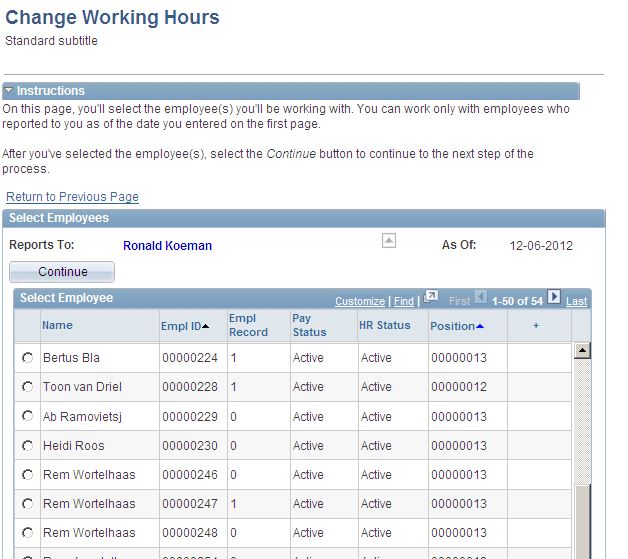Archive for the ‘HR’ Category
Direct Reports and loading the component
In Manager Self service, Direct Reports are being used to choose an employee and applying the self-serivce for this employee. The Direct Reports are called from peoplecode, which should be added to the post-build peoplecode of the MSS component. But however, the post-build peoplecode is fired after the component has been loaded initially. The initial load is based on the search record, and if this is the Installation record, then it is filled initially with the Emplid of the user, in this case the manager. If there is a database record being used on one of the pages of the component, then it will be filled with the data of the manager. If then after that a scroll flush and scroll select are being used with the data of the employee chosen from the direct reports, then the data of the manager will be overwritten. This could result in a database update!
An example: Manager John wants to use a Manager Self Service, for instance a position change for employee Jack. Suppose that for this self Service there is a new custom made Self Service, with direct Reports. When hitting the link, the page is initially filled with the data of manager John. But this is not yet visible. Now John sees the Direct Reports instead, and picks his employee Jack. Behind the screens, a scroll flush and a new scroll-select take place. So the data in the page containting the info of John is erased and replaced by the data of Jack. Now if there is a database record on the page, it results after a save in a database update, in which the data of John is replaced by the data of Jack. The could also be a read-only record on the page, that is only there for informational reasons, for instance a view on Job Data. Then a row of Job is updated with another emplid.
One solution, also used by PeopleSoft self, is a derived record on level 0, and on the scroll or grid on level 1 check “no auto select”. And the same for level 2 etc. Then the scroll-select after picking an employee from Direct Reports it is always considered as an insert. Another solution is using derived records only. And then insert from the SavePostChange peoplecode.
Oracle UPK (User Productivity Kit) – Chapter 5. Editing a UPK topic with the developer.
Oracle UPK (User Productivity Kit) – Chapter 5. Editing a UPK topic with the developer.
Greetings all,
In the previous chapter, we created our first “Hello world” outline and recorded a simple topic, navigating to the Oracle website.
This chapter will focus on the editing possibilities of the UPK Developer after a topic has been recorded.
Editing a UPK Topic
The UPK Editor opens after you recorded a topic or when you double-click on the topic in the outline (after recording).
The UPK Editor consists of 4 main parts:
- The recorded screen.
- The frame structure.
- Each time you select a frame from the structure, the properties and recorded screen change according to the selected frame.
3. Frame properties
- For each frame you can select the frame properties in this screen.
4. The main configuration items
Extending SmartHire (Template Based Hire) with custom Field Change & Field Prompt Events
‘Hiring new employees or adding contingent workers into the system is one of the most time-consuming tasks for Human Resources departments. Template-Based Hire reduces the current labor-intensive data entry process through the Personal Data and Job Data pages by providing a configurable, template-driven approach. Template Administrators can define default data for various sections or fields in the hiring process and they can determine what sections should be displayed, hidden and made equired to the end-user. This allows organizations to deploy policy control and flexibility in multiple template configurations for the end-users. This flexibility provides Human Resources departments the ability to decentralize the hiring process out to line managers or HR representatives in the field, rather than only allowing centralized hiring.’
Source: Red Paper Template Based Hire Red Paper for Human Resources 9.0.
Oracle UPK (User Productivity Kit) – Chapter 4. Recording a UPK topic and previewing
Greetings all,
In the previous chapter, we showed the steps to install the “UPK Developer single user” .
In the following chapter we will use the created “Hello World” outline to record and edit a topic.
This chapter will cover the following topics:
- How do we record a UPK topic?
- How do we preview a UPK topic?
Recording a UPK topic
In the previous chapter we ended with the following outline.








Value Propositions for HCM and FSCM 9.2
Today Oracle released their value propositions for both HCM and FSCM 9.2
What are the most outstanding items in their lists? There are some, but what leaps out most is the common list in both documents. Items like iPad certification (with Safari as browser) and Pivot Grids are nice, yet not HCM nor FSCM related. They come with the package deal (PeopleTools 8.52).
One more common item stands out before we run to the specific lists.